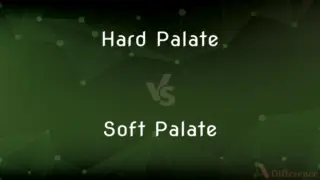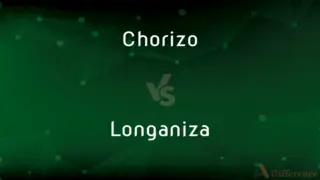Gorilla Glass 3 vs. Gorilla Glass 5 — What's the Difference?
By Tayyaba Rehman — Published on November 10, 2023
Gorilla Glass 3 introduced Native Damage Resistance for scratch resistance. Gorilla Glass 5 emphasizes drop protection, surviving drops from greater heights.

Difference Between Gorilla Glass 3 and Gorilla Glass 5
Table of Contents
ADVERTISEMENT
Key Differences
Gorilla Glass 3, produced by Corning, marked a significant improvement in the realm of glass durability. This version primarily focuses on Native Damage Resistance, a technology aimed to reduce the visibility of scratches and the loss of strength these imperfections can cause. As such, Gorilla Glass 3 devices tend to exhibit a robust resistance to daily wear and tear, which makes them particularly enduring in the face of minor damages.
In contrast, Gorilla Glass 5, while also a product of Corning, takes durability a notch higher. This version of Gorilla Glass was designed to address a common concern among users: drop performance. Corning's studies found that many drops occur from waist to shoulder height, and with Gorilla Glass 5, they aimed to provide protection for devices dropped from this range.
Another distinction between Gorilla Glass 3 and Gorilla Glass 5 is their target market at the time of release. When Gorilla Glass 3 was introduced, smartphones were the primary focus, ensuring they could withstand scratches from keys, coins, and other everyday objects. With Gorilla Glass 5, the focus shifted slightly, taking into account larger devices such as tablets and laptops, ensuring they too could endure accidental drops.
Lastly, while both Gorilla Glass 3 and Gorilla Glass 5 offer enhanced protection, it's essential to understand that no glass is entirely invulnerable. Gorilla Glass 5, however, promises a higher survival rate for drops from greater heights, making it a preferred choice for those who are more accident-prone.
Comparison Chart
Primary Focus
Native Damage Resistance (scratch resistance)
Drop protection from greater heights
ADVERTISEMENT
Drop Performance
Average
Enhanced
Market Focus at Release
Primarily smartphones
Smartphones, tablets, and laptops
Scratch Resistance
High due to Native Damage Resistance
Comparable, but emphasis on drop protection
Introduction Year
2013
2016
Compare with Definitions
Gorilla Glass 3
A protective screen layer introduced in 2013 for modern devices.
When I bought my phone in 2014, I made sure it had Gorilla Glass 3.
Gorilla Glass 5
A protective screen solution for a broader range of devices, from smartphones to laptops.
My new laptop's display has Gorilla Glass 5, making me less worried about accidents.
Gorilla Glass 3
A technological innovation in glass designed for electronic displays.
I'm glad my smartwatch uses Gorilla Glass 3; it's so resilient.
Gorilla Glass 5
A fifth-generation innovation prioritizing drops from significant heights.
Gorilla Glass 5 ensures my device can handle accidental tumbles.
Gorilla Glass 3
A durable and scratch-resistant glass developed by Corning.
My phone's Gorilla Glass 3 screen resisted all those accidental scratches.
Gorilla Glass 5
A 2016 introduction to Corning's lineup, emphasizing durability.
With Gorilla Glass 5, my phone feels much more robust and secure.
Gorilla Glass 3
A third-generation protective glass emphasizing Native Damage Resistance.
The Gorilla Glass 3 on my tablet remains pristine despite daily use.
Gorilla Glass 5
Corning's advanced glass known for superior drop protection.
I dropped my phone from waist height, but thanks to Gorilla Glass 5, it's fine.
Gorilla Glass 3
A chemically strengthened glass built to resist deep scratches.
Even after dropping my keys on it, the Gorilla Glass 3 was unscathed.
Gorilla Glass 5
A leap in protective glass technology, balancing scratch and drop resistance.
While Gorilla Glass 5 is great for drops, it also handles scratches like a champ.
Common Curiosities
How does Gorilla Glass 5 differ in its primary feature?
Gorilla Glass 5 focuses on providing superior drop protection from greater heights.
Can devices with Gorilla Glass 3 or 5 still break if dropped?
Yes, while they enhance durability, no glass is entirely unbreakable.
What was the primary enhancement in Gorilla Glass 3?
Gorilla Glass 3 introduced Native Damage Resistance for improved scratch resistance.
Which version is better for larger devices like tablets?
Gorilla Glass 5, due to its emphasis on drop protection from greater heights.
When were Gorilla Glass 3 and Gorilla Glass 5 introduced?
Gorilla Glass 3 was introduced in 2013, while Gorilla Glass 5 came in 2016.
Is Gorilla Glass 5 more scratch-resistant than Gorilla Glass 3?
Both offer good scratch resistance, but Gorilla Glass 5's main emphasis is on drop protection.
Is Gorilla Glass 5 more expensive than Gorilla Glass 3?
The cost can vary based on manufacturers and device types, but generally, newer technology may come at a premium.
Which Gorilla Glass version is better for outdoor activities?
Gorilla Glass 5, with its enhanced drop protection, might be more suitable.
Were both versions designed by Corning?
Yes, both Gorilla Glass 3 and Gorilla Glass 5 are products of Corning.
Which devices typically use Gorilla Glass 3?
Many smartphones released around 2013-2015 featured Gorilla Glass 3.
Are there any downsides to using devices with Gorilla Glass 5?
While it offers enhanced drop protection, no glass is entirely immune to breaking or scratching.
Do I need a screen protector with Gorilla Glass 3 or 5?
While both versions are durable, a screen protector can offer additional peace of mind.
Are there versions of Gorilla Glass after 5?
Yes, Corning has developed versions beyond Gorilla Glass 5, each with its advancements.
Can Gorilla Glass 3 or 5 resist scratches from keys or coins?
Yes, both versions offer resistance against such common scratch-causing objects.
How can I identify if my device has Gorilla Glass 3 or 5?
You can refer to your device's specifications or the manufacturer's information.
Share Your Discovery

Previous Comparison
Hard Palate vs. Soft Palate
Next Comparison
Chorizo vs. LonganizaAuthor Spotlight
Written by
Tayyaba RehmanTayyaba Rehman is a distinguished writer, currently serving as a primary contributor to askdifference.com. As a researcher in semantics and etymology, Tayyaba's passion for the complexity of languages and their distinctions has found a perfect home on the platform. Tayyaba delves into the intricacies of language, distinguishing between commonly confused words and phrases, thereby providing clarity for readers worldwide.












































